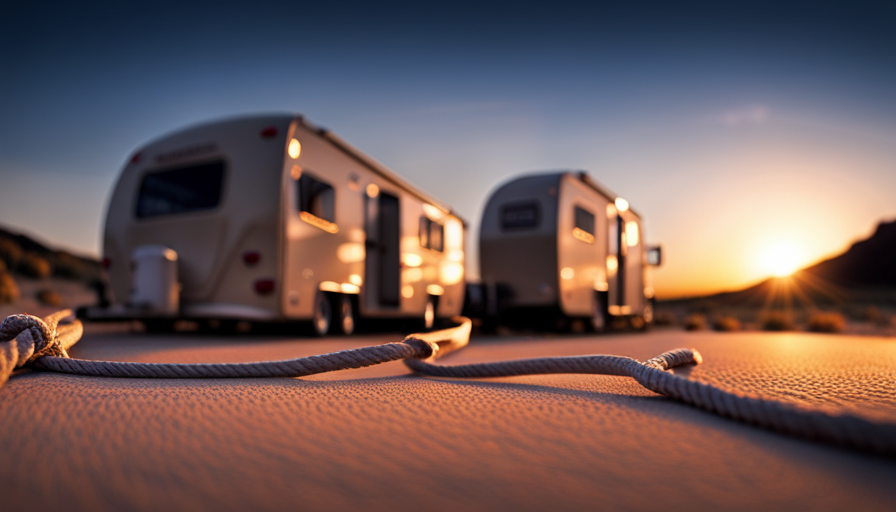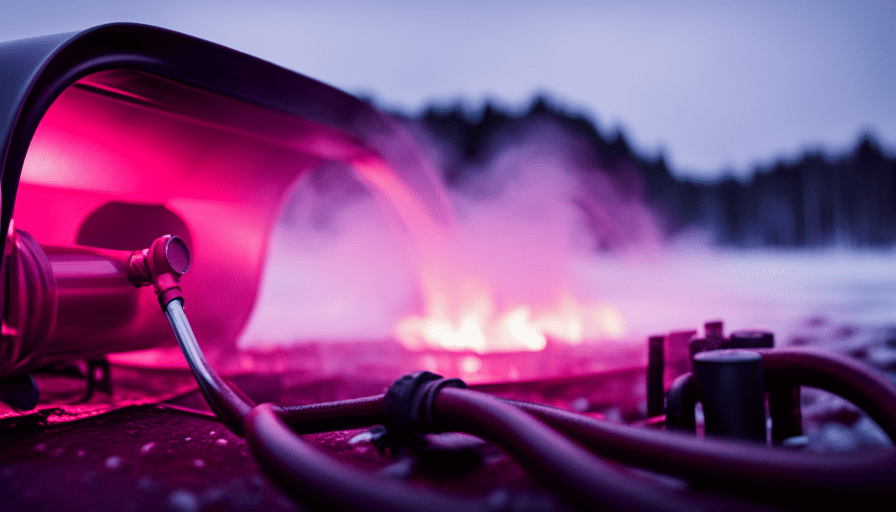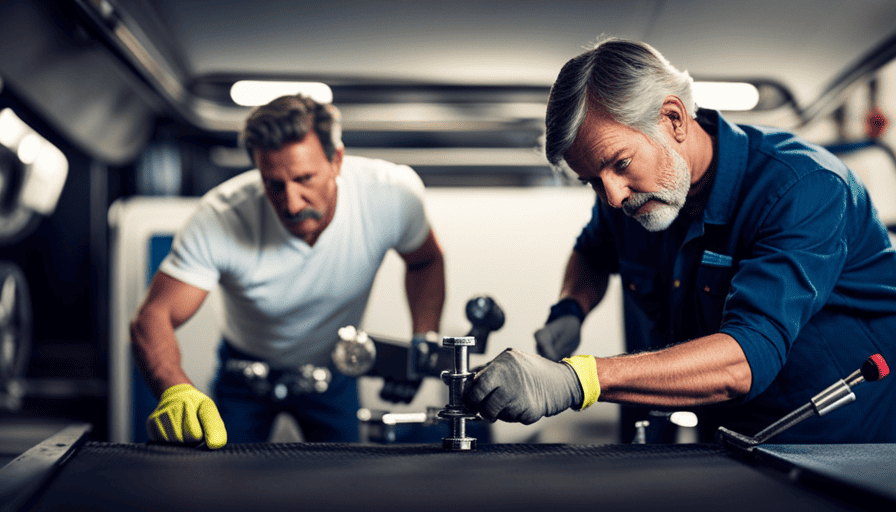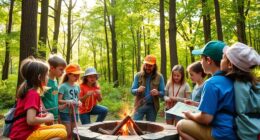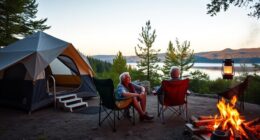The size of a camper, similar to the winding road ahead, can sometimes be a challenge to measure. But fear not, adventurers! I am here to help as your trusty guide, excited to unveil the secrets of measuring a camper’s length.
Picture this: you’re embarking on a thrilling camping trip, and you need to determine the size of your faithful companion, your camper. Whether you’re looking to upgrade your rig or simply find the perfect campsite, accurate measurements are your compass in this vast world of camping.
So, grab your measuring tape and let’s dive in! In this article, I’ll walk you through the step-by-step process of measuring camper length, from gathering the necessary tools to recording and double-checking your measurements. Together, we’ll unlock the key to selecting the ideal campsite and ensure a smooth and delightful camping experience.
So, my fellow explorers, let’s embark on this journey of measurement mastery!
Key Takeaways
- Accurate measurements of a camper’s length are important for various reasons, including choosing the right campsite and accessories, ensuring proper navigation and weight distribution.
- The tools needed to measure camper length include a tape measure, notepad, pen, and a ladder.
- To measure the length of a camper, start at the front edge and measure the exterior length from front to back, including any protruding parts. Then, measure the interior length by removing obstacles and measuring from the back to the front wall. Consider the width and height of the interior space as well.
- When measuring attachments such as awnings or bike racks, measure them in their fully extended or maximum position as they can affect the overall length of the camper.
Importance of Measuring Camper Length
You should understand the importance of measuring the length of your camper to ensure proper fit and avoid any potential issues. Accurate measurements are crucial when it comes to finding the right size for your camper.
Knowing the exact length of your camper has several benefits. Firstly, it allows you to choose the appropriate campsite or parking space. Some campsites have size restrictions, and knowing your camper’s length ensures that you won’t encounter any unexpected limitations.
Secondly, accurate measurements help you select the right accessories and equipment for your camper. Whether it’s a cover, awning, or bike rack, knowing the length of your camper ensures a perfect fit and avoids wasted time and money.
Additionally, understanding the length of your camper helps with navigation and maneuvering. It allows you to plan your route effectively, avoiding low bridges or narrow roads.
Lastly, accurate measurements contribute to the overall safety and stability of your camper. By knowing its length, you can distribute weight evenly and avoid any imbalance issues.
So, now that you understand the importance of accurate measurements, let’s move on to the next step: gathering the necessary tools.
Gather the Necessary Tools
Grab your trusty tape measure and prepare to embark on a journey of discovery as you delve into the world of quantifying the dimensions of your beloved home on wheels. When it comes to measuring the length of your camper, accuracy is key. A slight miscalculation can result in costly mistakes when it comes to parking or fitting your camper into storage spaces.
To ensure precise measurements, gather the necessary tools for the job. Here are a few items you’ll need:
- A tape measure with both metric and imperial units for versatility.
- A notepad and pen to jot down measurements for reference.
- A sturdy step ladder to reach the higher points of your camper.
Now that you have the tools at your disposal, it’s important to emphasize the significance of accuracy. Even the smallest measurement mistake can lead to difficulties down the road. It’s common for people to overlook small details or make assumptions, resulting in inaccurate measurements. By taking the time to measure your camper correctly, you can avoid unnecessary hassles and ensure a smooth journey.
With the tools in hand and the importance of accuracy in mind, it’s time to move on to the next step: locating the starting point for measurement.
Locate the Starting Point
Before embarking on the journey of accurately quantifying the dimensions of your mobile home, it’s crucial to locate the starting point for measurement, setting the foundation for a meticulous assessment. To ensure accuracy, it is important to use a measuring tape and a level to guarantee precise measurements. Here is a handy table to help guide you through the process:
| Tool | Purpose |
|---|---|
| Measuring tape | Determines length accurately |
| Level | Ensures a straight and level starting point |
To locate the starting point, position yourself at the front of the camper. Place the measuring tape at the very front edge, ensuring it is flush against the wall. Extend the tape along the entire length of the camper until you reach the end. Take note of the measurement and mark it as the starting point.
By using this measuring technique, you can establish an accurate starting point for measuring the exterior length of your camper. This will provide a solid foundation for the subsequent section on how to measure the exterior length without missing any crucial details.
Measure the Exterior Length
Start by using a measuring tape and level to accurately determine the dimensions of your mobile home, ensuring a straight and level starting point. Did you know that the average exterior length of a mobile home is around 60 feet?
To measure the exterior length of your camper, begin at the front of the trailer and extend the measuring tape all the way to the back. Make sure to measure from the outermost points, including any protruding parts like bumpers or hitches. This will give you an accurate measurement of the overall length of your camper.
Knowing the exterior length of your camper is essential when considering parking and storage options. It will help you determine whether your mobile home will fit in a designated space or if you need to make any adjustments. Additionally, understanding the exterior length can give you an idea of the interior space and storage capacity of your camper.
Next, we will move on to measuring the interior length of your mobile home. By accurately measuring both the exterior and interior dimensions, you will have a comprehensive understanding of the size and layout of your camper, allowing you to make informed decisions when it comes to planning your camping adventures.
Measure the Interior Length
Once you’ve determined the exterior dimensions of your mobile home, it’s time to explore the spacious interior and uncover the true length of your camper.
To accurately measure the interior length, you’ll need to utilize specific measuring techniques and take into account the overall dimensions of the living space.
Start by removing any furniture or belongings that might obstruct your measurements. Use a tape measure to measure the distance from the back wall to the front wall of the camper. Make sure to measure from the inside of the walls to get an accurate measurement.
Additionally, measure the width and height of the interior space to capture a complete understanding of the dimensions. Take note of any irregularities or protrusions, such as cabinets or appliances, that may affect the measurements.
Once you have gathered all the necessary measurements, you can confidently determine the interior length of your camper. With this information, you can now consider any additional attachments that may extend the overall length of your camper, such as awnings or bike racks.
Consider Any Additional Attachments
When it comes to measuring the interior length of a camper, there are a few things you need to consider. In my experience, it’s important to take into account any additional attachments that may affect the overall length. These attachments could include things like awnings, bike racks, or spare tire carriers. They can add a few extra feet to the camper’s length, so it’s crucial to measure with them in mind.
To ensure measuring accuracy, I recommend taking the measurements with the attachments fully extended or in their maximum position. This will give you the most accurate measurement of the camper’s total length.
When measuring, it’s also helpful to use a nested bullet point list to keep track of the different measurements and attachments:
-
Measure the interior length of the camper without any attachments
-
Extend or position the attachments to their maximum length
-
Measure the additional length added by each attachment
By following these steps and considering any additional attachments, you can ensure that your measurements are precise and accurate. This is crucial when it comes to planning for storage or determining if the camper will fit in a specific space.
Now that we’ve measured the interior length and considered any additional attachments, it’s time to record and double-check the measurements.
Record and Double-Check the Measurements
To ensure absolute precision, make sure to jot down and meticulously cross-reference the measurements you’ve taken, capturing every minute detail that will determine the perfect fit for your camper. Double-checking measurements is essential to avoid common measurement mistakes that could lead to an ill-fitting camper.
One common mistake is failing to record measurements accurately, which can result in a camper that is too big or too small for your needs. Another mistake is not double-checking the measurements against the camper’s specifications, which can lead to costly errors.
It’s also important to consider any additional attachments you may have on your camper, such as awnings or bike racks, and factor those into your measurements.
By taking the time to double-check your measurements and consider all attachments, you can ensure that your camper will fit perfectly at any campsite you choose. This will allow you to make the most of your camping experience without any unexpected surprises.
Use the Measurements for Campsite Selection
Now that you have the precise measurements, you can easily find the perfect campsite that will accommodate your camper without any surprises. It’s important to consider the campsite amenities and campground regulations when making your selection.
Start by looking for campsites that offer the amenities you need, such as electrical hookups, water connections, and dump stations. Some campgrounds even have amenities like swimming pools, playgrounds, and laundry facilities.
Make sure to check if there are any restrictions on camper length or vehicle size at the campsite you’re considering. This will ensure that your camper fits within the designated space and that you won’t be turned away upon arrival.
Additionally, familiarize yourself with any campground regulations regarding noise levels, pet policies, and quiet hours to ensure a peaceful and enjoyable camping experience.
By considering these factors, you can find a campsite that meets your needs and provides a comfortable stay for you and your camper.
Now, let’s move on to some tips for choosing the right campsite.
Tips for Choosing the Right Campsite
Discover your perfect campsite by following these tips and create memories that will last a lifetime. When choosing a campsite location, there are a few key factors to consider. First, think about the amenities that are important to you. Are you looking for a campsite with electricity and running water, or are you more interested in a secluded spot off the beaten path? Consider what facilities are available at each campsite and choose one that meets your needs.
To help you make a decision, here is a handy table that compares different campsites based on their amenities:
| Campsite | Electricity | Running Water | Picnic Tables | Restrooms |
|---|---|---|---|---|
| Campsite A | Yes | Yes | Yes | Yes |
| Campsite B | No | Yes | No | Yes |
| Campsite C | Yes | No | Yes | No |
| Campsite D | No | No | No | No |
By comparing the amenities offered at each campsite, you can easily find the one that suits your preferences. Once you have chosen the perfect campsite, you can focus on enjoying a smooth camping experience.
Enjoy a Smooth Camping Experience
Having a hassle-free camping experience is possible with proper planning and preparation. When it comes to enjoying a smooth camping experience, having the right camping gear is essential. Make sure to check your camping equipment before heading out, ensuring that everything’s in good working condition. This includes your tent, sleeping bags, cooking utensils, and any other gear you might need.
Another important aspect of a smooth camping experience is campfire safety. Before starting a campfire, check the rules and regulations of the campsite regarding fire safety. Always choose a designated fire pit and clear the area around it from any flammable materials. Keep a bucket of water nearby and never leave the fire unattended. It’s also important to fully extinguish the fire before leaving the campsite or going to sleep.
In addition to these tips, it’s helpful to have a camping checklist to ensure you’ve got everything you need. This’ll help you avoid forgetting any essential items and make your camping experience more enjoyable. Lastly, don’t forget to pack some entertainment options like board games or a deck of cards to keep yourself and your fellow campers entertained during downtime.
With these tips in mind, you’ll be well-prepared for a smooth and enjoyable camping experience.
Frequently Asked Questions
How do I measure the height of my camper?
To measure the height of your camper, start by finding a level surface and park your camper on it. Use a measuring tape to measure from the ground to the highest point of your camper’s roof. It’s important to note that different types of campers may require different measuring techniques. For example, pop-up campers may need to be fully extended before measuring. Knowing how to measure camper width is also crucial for a complete understanding of your camper’s dimensions.
Can I measure the camper length by using a tape measure alone?
Yes, you can measure the camper length using a tape measure alone. To determine the camper size accurately, start by extending the tape measure from the front to the rear of the camper, measuring from the outermost points. Make sure to include any additional length from attachments like bumpers or spare tires.
By measuring the camper width as well, you can get a comprehensive understanding of its dimensions and make informed decisions when it comes to storage or transportation.
Should I include the hitch in the camper length measurement?
Yes, it’s essential to include the hitch in the camper length measurement. The hitch weight plays a crucial role in how the camper handles during travel. By accurately measuring the entire length of the camper, including the hitch, you can determine the weight distribution and ensure safe towing.
Accurate measurements are vital for determining the hitch weight and ensuring that your camper is properly balanced and secure on the road.
Are there any specific tools or techniques to measure the interior length accurately?
To measure the interior length of a camper accurately, I suggest using a tape measure and a straightedge. Start by removing any obstructions, such as furniture or curtains, to get an unobstructed measurement.
Place the tape measure at one end of the interior and extend it to the other, following the contours of the walls. Make sure to measure both the widest and narrowest points to get an accurate understanding of the camper’s width.
This technique ensures precise measurements for determining the interior length of your camper.
What are some common mistakes people make when measuring their camper length?
Common misconceptions about camper length measurement often stem from not taking into account certain factors.
One common mistake is not considering the protrusions, such as awnings or bike racks, that may add to the overall length.
Another mistake is not properly measuring the tongue or hitch, which can significantly impact the total length.
To accurately measure the length of a camper, it’s important to take these factors into consideration and use a measuring tape to get precise measurements.
Are the Methods for Measuring a Camper’s Length the Same for Different Types of Campers?
When it comes to measuring a camper accurately, the methods may vary depending on the type of camper. For example, a pop-up camper may require different measurement techniques than a motorhome. It’s important to use the appropriate tools and methods to ensure accuracy when measuring a camper’s length, regardless of its type.
Conclusion
In conclusion, accurately measuring your camper length is crucial for a seamless camping adventure. By gathering the necessary tools, locating the starting point, and measuring both the exterior and interior length, you can ensure precise measurements.
Recording and double-checking these measurements will further guarantee accuracy. Utilizing these measurements for campsite selection will allow you to find the perfect spot for your camper. Remember to consider tips for choosing the right campsite to enhance your overall experience.
So, start measuring and embark on a marvelous camping journey!



